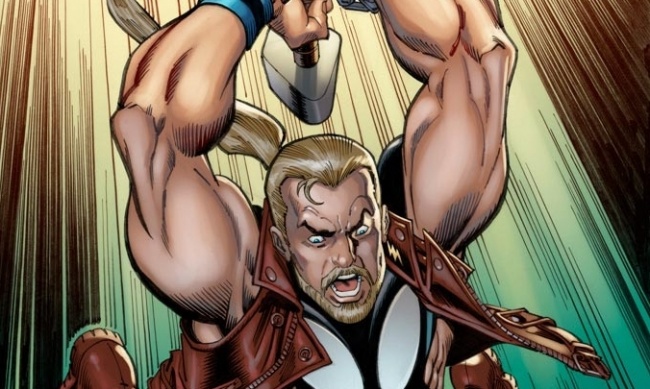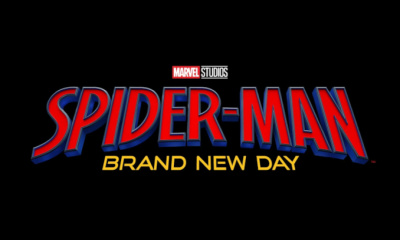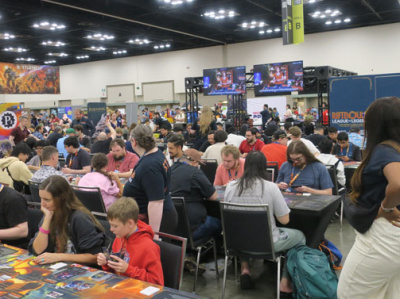Marvel recently announced a month of 1990s-themed variant covers featuring work by many of the hot artists from that era (see: "Preview: Marvel ‘92 Variants"). It’s a nice bit of service for fans from that era, the youngest of whom are now pushing 30 (!). It’s also a reminder that in comics, as in William Faulkner’s old South, the Past isn’t dead; it isn’t even Past.
Comics So Bright You Gotta Wear Shades. The early 90s is a peculiar moment in comics history to pay tribute to. For slightly older fans like myself, the aesthetics of mid-1990s mainstream comic art are best left forgotten. This was the era of steroid anatomy that made Jack Kirby look like a photorealist by comparison; mostly-naked lady vampires with pneumatic boobs; pins-and-needles inking styles wherein the embellishers seemed to be paid by the pen-stroke; and "hey look what we can do with Photoshop!" coloring effects.
The storylines featured endless crossovers sprawling across dozens of titles, with each overpriced variant-cover issue moving the headache-inducing plot forward by inches. Image, as they used to say, was everything. Oh, and clones. Let’s please not forget the clones.
The Roaring 90s. The larger-than-life storytelling style popular in 1990s comics was matched by the swaggering business environment. Early in the decade, comics hit sales peaks not seen since the pre-code days of the late 1940s, with titles routinely selling in the hundreds of thousands, and a few breakout books like X-Men #1 (1992) hitting the millions. Creators were getting rich, new publishers were spinning up, and comic shops were crowded with fans scarfing up multiple copies that they figured were good as gold.
For a while, they were right. A general economic recovery, combined with the demographic effect of Baby Boomer fans who grew up in the 1960s achieving incomes high enough to start buying up back issues from their youth, and media attention from events like the "Death of Superman," created a bull market for pop culture collectibles of all kinds, from cards to toys, but comics lead the charge.
Publications fed this frenzy by putting out monthly price guides pointing fans to "hot books" guaranteed to appreciate in value. Unfortunately, no one had revoked the law of supply and demand. Retailers and collectors learned the hard way that titles with print runs in the hundreds of thousands were not exactly scarce collector’s items, no matter how many articles in Wizard said they were, and pretty soon the bottom started to fall out.
Falling on Black Days. By 1995, twenty years ago, the speculator bubble was bursting but the supply chain hadn’t quite figured that out yet. Retailers were still massively over-ordering and publishers were under-delivering. Solicited titles came out late, or not at all. Readers were losing interest and collectors were starting to realize that they weren’t going to be able to fund their retirement with the cases of Spawn #1 secreted away in their attics.
Perhaps the most unfortunate business development of the era was Marvel’s attempt to consolidate distribution by purchasing Heroes World, at the time the third largest distributor to the direct market. Faced with the threat of losing 35-40% of their sales volume overnight with no way to reduce costs, the remaining distributors – Diamond and Capital City – desperately attempted to lock up the other publishers into exclusive agreements.
Diamond came out on top, acquiring Capital City in July of 1996. In the meantime, Marvel’s Heroes World move failed spectacularly. Incapable of supporting retailer demand, the distributor’s blunders helped drive many already-struggling comic stores out of business. Marvel eventually pulled the plug, but the damage had been done. Diamond was the only distributor remaining capable of serving the entire direct market, and from that moment on, for better or worse, had the field almost entirely to itself.
Barbarians at the Gate. Marvel, meanwhile, under the management of Wall Street operators Carl Icahn and Ron Perelman, had overextended itself with a series of ill-fated acquisitions. In addition to Heroes World, Marvel had purchased trading card companies Fleer and Skybox, an Italian sticker company called Panini, and ToyBiz, in addition to starting up a film production studio. When these investments went bad in the mid-90s, a power struggle between Perelman and Icahn drove Marvel Entertainment Group into bankruptcy, from which it was purchased and reorganized by ToyBiz owners Ike Perlmutter and Avi Arad.
It was in this era that a cash-desperate Marvel Enterprises licensed the film rights to blue-chip properties Spider-Man, X-Men and the Fantastic Four to Sony and 20th Century Fox, with repercussions rippling down to the present day.
Hindsight is 20:20. It’s often said that the "Golden Age of Comics" is whatever was being published when you were 10-12 years old, and I guess that’s true even of an era like the mid-90s.
Of course, beyond the mainstream, things weren’t all bad. This period was the dawn of the modern graphic novel era, with groundbreaking work like Joe Kubert’s Fax from Sarajevo, Seth’s It’s a Good Life if You Don’t Weaken, Will Eisner’s To the Heart of the Storm and other classics beginning to appear on bookshelves and get taken seriously. Manga, young adult genre fiction, and webcomics were starting to widen the comic demographic beyond the core 20-something male, laying the foundations of today’s more diverse fandom. DC and Vertigo were doing interesting stuff as well: this was the heyday of Preacher, Transmetropolitan, The Invisibles and Sandman Mystery Theatre.
Perhaps this isn’t the set of associations that Marvel was hoping to trigger with its retro-covers. But if this trip down memory lane tugs at the heartstrings, I understand there’s a very good overview of comics in the 1990s coming as part of the American Comic Book Chronicles series from comics historian Jason Sacks on TwoMorrows Publishing, likely coming out next year.
Rob Salkowitz (@robsalk) is author of Comic-Con and the Business of Pop Culture, and consults with businesses interested in engaging with fandom and conventions.
The opinions expressed in this column are solely those of the writer, and do not necessarily reflect the views of the editorial staff of ICv2.com.

Column by Rob Salkowitz
Posted by Rob Salkowitz on September 7, 2015 @ 5:36 pm CT
MORE COMICS
YouTuber's Self-Published First Volume Sold 200,000 Copies DTC
August 11, 2025
The self-published edition of the first volume of the YouTuber’s graphic novel sold over 200,000 copies direct to consumers when it was released in 2024.
Showbiz Round-Up
August 11, 2025
The summer heat is on, and Hollywood news is boiling over. Time for a round-up!
MORE COLUMNS
Column by Scott Thorne
August 11, 2025
This week, columnist Scott Thorne notes a new twist in the Diamond Comic Distributors saga and shares his thoughts on the Gen Con releases that will make the biggest impacts.
Column by Jeffrey Dohm-Sanchez
August 7, 2025
ICv2 Managing Editor Jeffrey Dohm-Sanchez lays out the hotness of Gen Con 2025.








